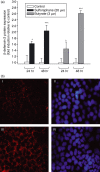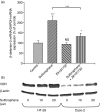The dietary histone deacetylase inhibitor sulforaphane induces human beta-defensin-2 in intestinal epithelial cells
- PMID: 18373608
- PMCID: PMC2561129
- DOI: 10.1111/j.1365-2567.2008.02834.x
The dietary histone deacetylase inhibitor sulforaphane induces human beta-defensin-2 in intestinal epithelial cells
Abstract
Antimicrobial peptides like human beta-defensin-2 (HBD-2) play an important role in the innate immune system protecting the intestinal mucosa against bacterial invasion. The dietary histone deacetylase (HDAC) inhibitors sulforaphane (SFN) and butyrate have received a great deal of attention because of their ability to simultaneously modulate multiple cellular targets involved in cellular protection. In this study the influence of SFN and butyrate on HBD-2 expression as well as the molecular pathways involved in SFN-mediated induction of HBD-2 were scrutinized. Treatment of Caco-2, HT-29 and SW480 cells with SFN led to a time- and dose-dependent upregulation of HBD-2 mRNA expression as determined by semi-quantitative reverse transcription-polymerase chain reaction. Moreover, HBD-2 protein production increased in response to SFN, measured by enzyme-linked immunosorbent assay. Induction of HBD-2 was also observed in response to butyrate. Immunofluorescence analysis revealed that the protein was localized in the cytosol. Coincubation of SFN with a vitamin D receptor (VDR), or an extracellular-regulated kinase 1/2 or a nuclear factor-kappaB inhibitor all reduced HBD-2 mRNA upregulation. In contrast, transfection of cells with a dominant-negative peroxisome proliferator-activated receptor gamma (PPARgamma) mutant vector to inhibit PPARgamma wild-type action and inhibition of p38 mitogen-activated protein kinase (MAPK) signalling did not affect SFN-mediated upregulation of HBD-2 mRNA. Moreover, SFN induced the expression of VDR, PPARgamma and phosphorylated ERK1/2 but did not affect p38 MAPK activation. The data clearly demonstrate for the first time that the dietary HDAC inhibitor SFN is able to induce antimicrobial peptides in colonocytes. In this process HBD-2 expression is regulated via VDR, mitogen-activated protein kinase kinase/extracellular-regulated kinase and nuclear factor-kappaB signalling.
Figures





References
-
- Wehkamp J, Stange EF. Paneth cells and the innate immune response. Curr Opin Gastroenterol. 2006;22:644–50. - PubMed
-
- Sansonetti PJ. War and peace at mucosal surfaces. Nat Rev Immunol. 2004;4:953–64. - PubMed
-
- Ganz T. Defensins: antimicrobial peptides of innate immunity. Nat Rev Immunol. 2003;3:710–20. - PubMed
-
- Zasloff M. Antimicrobial peptides in health and disease. N Engl J Med. 2002;347:1199–200. - PubMed
-
- Wehkamp J, Schmid M, Fellermann K, Stange EF. Defensin deficiency, intestinal microbes, and the clinical phenotypes of Crohn's disease. J Leukoc Biol. 2005;77:460–5. - PubMed
Publication types
MeSH terms
Substances
LinkOut - more resources
Full Text Sources
Research Materials
Miscellaneous

